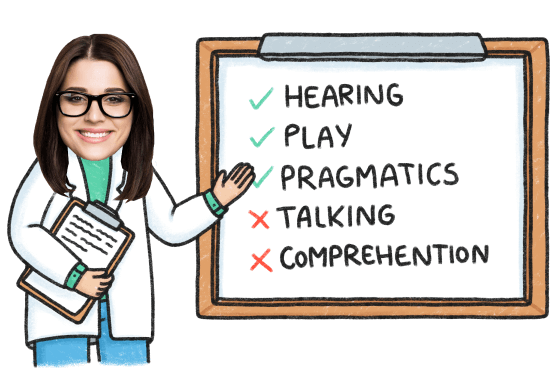Should I Wait for My 2-Year-Old to Start Talking?
Jan 27, 2022 If your doctor advises you to wait, it probably means your child’s speech is their expressing intentions through cues and understanding instructions.
So, the doctor said your 2-year-old will eventually start talking, but you’re worried. A spoken exchange includes intent, production, and comprehension.
In This Article
If you spoke to your child a lot before birth, they will understand language much sooner than they talk. Making intelligible speech requires breath control from and by the lungs, through the pharynx for sound, and then the oral and nasal cavities for sound manipulation. That’s a lot of physical work for a 2-year-old who’s never sounded out a word before.
Language delays are usually due to the still-developing speech apparatus of the child and/or longer processing of the spoken sounds and words.
If you need professional help and require diagnostic tests, the decision to wait is up to you, even if your doctor recommends it, because it’s only a matter of time until your child starts talking. Toddler speech development is different for every child, so don’t worry.
Factors Influencing Speech Delay
Before discussing how to help your child’s speech at home, let’s identify a few factors that may be the cause of longer response time and overall speech delays.
Raising a Child in a Multilingual Home
Speaking more than one language at home means more and longer language processing. A bilingual child requires more processing time than a monolingual child, and first words or sentences usually come later. But don’t get discouraged, you multilingual families. In fact, there are many cognitive benefits of speaking more than one language, i.e. increased efficiency in task-switching, multitasking, creativity, and more!
Interestingly enough, bilingual children do not confuse their spoken languages with one another, but rather understand them as distinct and separate systems.
Excessive TV Time

A range of studies has shown that TV does very little to help language learning in children under 2. When compared to live interaction, picking up language from television is by far the weaker choice.
Jim, a hearing boy born to deaf parents, spent a lot of time watching TV as it was his primary exposure to English. By the age of almost 4, not only was his language delayed, but he knew very little about how to put words together to form grammatical sentences. His sentences went as follows: This is how plane; I want that make; House chimney my house chimney (Saxton, 2018; Sachs, Bard, & Johnson 1981).
The American Academy of Pediatrics (AAP) recommends no TV for children under the age of 2; and no more than 2 hours/day for children over the age of 2. For the latter age group, slow paced-television shows like Sesame Street and Blue’s Clues are encouraged, as they focus on promoting problem-solving skills, story comprehension, and pattern recognition.
The Speech Blubs app also fits into this category as it’s a voice-controlled speech therapy app that contains lots of fun expert-approved activities aimed at improving your child’s overall language abilities.
Boost Your Child’s Speech Development!
Improve language & communication skills with fun learning!

What Should I Do while I Wait for My Child’s First Words?
Interact! Have a conversation!
Nature has already done its part; the human brain is innately predisposed to acquiring language. To take full advantage of this ability, speaking and interaction are essential.
The language children hear from parents and others is the fuel that allows the machine to run and produce a mature knowledge of language as its end product.
Matthew Saxton (2018)
As illustrated in the case of Jim, input alone is insufficient for language fluency. Have you ever sung a song and realized that you don’t know what the lyrics mean? Right! Input must be combined with interaction. It’s through interaction that we practice expressing our intentions in words.
Research finds that the more interactive and talkative parents are with their children, the more children benefit from complex grammar acquisition and speech processing. This benefit comes from parents’ use of rich vocabularies, sentences, ideas at home, and in conversations with the child. That said, talking with your child is something to consider even in a busy age of working moms and dads.
What You Can Do Now
Here are some things to do with your child to encourage language development.
- Practice greeting your child regularly. “Good morning, Goodnight, Hello, Goodbye.” Ask your child to get something for you while pointing at the object. It always helps to give a little praise when the child gets it right.
- Try to elicit a response by asking exciting questions. “Do you want to go to the park? Do you want juice?” By also drawing out emotions, over time, you can get a one-word response like “Park!” or “juice!”
- Talk about the here-and-now. Kids learn better when the talked-about object is within their line of sight. “Look! A train.”
- Though we are limiting TV time, kids love when others take interest in their favorite slow-paced TV shows. It’s an excellent time for bonding and interaction. You can learn the theme song of the show, show interest in the story-plot, call out the objects on the screen while pointing, and even express a sense of surprise by cool displays. Your child will find this exciting and start imitating you to get your attention on things they find interesting. The same also applies to reading and playtime with toys.
- Encourage play with other friends. The average child makes friends by the age of 2. Others in their age group will have similar interests. Play will be communicative and include observation, imitation, and cooperation.
- Lastly, interact with your child as you would with anyone else. Talk about everything and anything that is directly relevant to the child. “Who’s ready for a shower,” “Are you hungry?” “Let’s go eat some pizza,” “Can you get your shoes for me,” “Can you help me wash my car today?” “Do you wanna go with me to the store,” “Can you put your socks on by yourself?” “Wow, you did it” “Great job!” and “High five!”
Characteristics of Child-Directed Speech (CDS)

We talk differently to different people. Think how you might speak to a potential boss at a job interview. Now compare that with a close friend, a partner, or a sibling. Chances are you speak differently for each. We do the same when we talk to infants and toddlers. We refer to this register as child-directed speech (CDS).
Child-directed speech is dynamic. Rather than being fixed, parents subconsciously fine-tune/modify the register of CDS as the child ages and as their language improves. The changes to CDS are subtle and difficult to detect; however, with these changes being applied on a day-to-day basis, parent’s eventually will reach Adult-directed speech (ADS) with their child after an extent of maturity/age is reached.
In child-directed speech, we speak slowly, we increase the pitch of our voices, we exaggerate, and stress our emotions. Although CDS is not required to pick up language, it allows for better speech processing and understanding of the roles that stress, pitch, duration, and loudness play in revealing emotions, as well as helping to differentiate questions from commands and declarative sentences.
Don’t worry, you’ll get your toddler talking before you know it. Call a speech-language pathologist and have your child tested if there’s any doubt. Also, practice with Speech Blubs, to practice first sounds and words.
References:
- Saxton, M. (2018). Child Language: Acquisition and Development. SAGE Publications Ltd.
- Strunk, S. J. D., Bard, B., & Johnson, M. L. (1981). Language Learning with Restricted Input: Case Studies of Two Hearing Children of Deaf Parents. Cambridge University Press.

